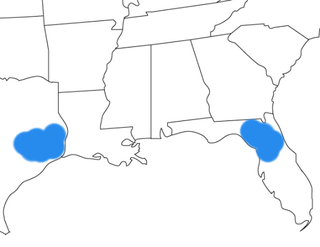 W
WA peccary is a medium-sized pig-like hoofed mammal of the family Tayassuidae. They are found throughout Central and South America and in the southwestern area of North America. They usually measure between 90 and 130 cm in length, and a full-grown adult usually weighs about 20 to 40 kg.
 W
WPlatygonus compressus, the flat-headed peccary, is an extinct mammal species from the Tayassuidae-family, that lived in North-America during the Pleistocene. It was first described in 1848 by John L. Leconte.
 W
WPlatygonus is an extinct genus of herbivorous peccaries of the family Tayassuidae, endemic to North and South America from the Miocene through Pleistocene epochs, existing for about 10.289 million years .
 W
WThe Chacoan peccary or tagua is the last extant species of the genus Catagonus; it is a peccary found in the Gran Chaco of Paraguay, Bolivia, and Argentina. Approximately 3,000 remain in the world. It is believed to be the closest living relative to the extinct genus Platygonus.
 W
WThe Chacoan peccary or tagua is the last extant species of the genus Catagonus; it is a peccary found in the Gran Chaco of Paraguay, Bolivia, and Argentina. Approximately 3,000 remain in the world. It is believed to be the closest living relative to the extinct genus Platygonus.
 W
WFloridachoerus olseni is an extinct peccary that lived during the Hemingfordian age of the Early Miocene, and was endemic to North America. F. olseni was in existence for approximately 4.46 million years . Remains of this extinct mammal were located at the fossil rich Thomas Farm site in Gilchrist County, Florida and Toledo Bend site, Newton County, Texas. Floridachoerus olseni was named after Stanley. J. Olsen of the Florida Geological Survey in 1962. Olsen previously worked at the site for Harvard University.
 W
WPecari is a genus of mammals in the peccary family, Tayassuidae. The genus was monotypic until the description of P. maximus in 2007, but the scientific evidence for its status as a species separate from P. tajacu has later been questioned, leading the IUCN to treat it as a synonym.
 W
WThe collared peccary is a species of mammal in the family Tayassuidae found in North, Central, and South America. They are commonly referred to as javelina, saíno, or báquiro, although these terms are also used to describe other species in the family. The species is also known as the musk hog. In Trinidad, it is colloquially known as quenk.
 W
WThe white-lipped peccary is a peccary found in Central and South America. Most of its range is in rainforests, but it is also known from a wide range of other habitats such as dry forests, grasslands, mangrove, Cerrado, and dry xerophytic areas. It lives in herds of 20–300 individuals that typically take up about 120 km2 (46 sq mi) to fully function. Members of this species are omnivorous, feeding mostly on fruit, and are usually found traveling great distances to obtain it. If this resource is in demand and difficult to find, peccaries eat leaves, stems, or animal parts. White-lipped peccaries have several unique attributes that allow them to stay with and identify their herd, which is essential for their survival in the wild.
 W
WA peccary is a medium-sized pig-like hoofed mammal of the family Tayassuidae. They are found throughout Central and South America and in the southwestern area of North America. They usually measure between 90 and 130 cm in length, and a full-grown adult usually weighs about 20 to 40 kg.
 W
WThe white-lipped peccary is a peccary found in Central and South America. Most of its range is in rainforests, but it is also known from a wide range of other habitats such as dry forests, grasslands, mangrove, Cerrado, and dry xerophytic areas. It lives in herds of 20–300 individuals that typically take up about 120 km2 (46 sq mi) to fully function. Members of this species are omnivorous, feeding mostly on fruit, and are usually found traveling great distances to obtain it. If this resource is in demand and difficult to find, peccaries eat leaves, stems, or animal parts. White-lipped peccaries have several unique attributes that allow them to stay with and identify their herd, which is essential for their survival in the wild.